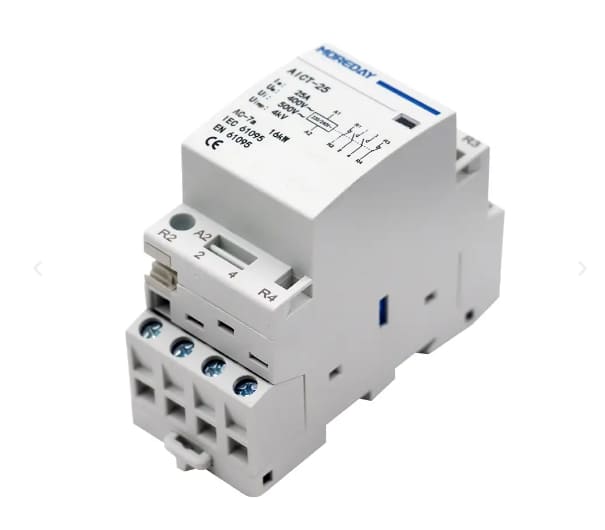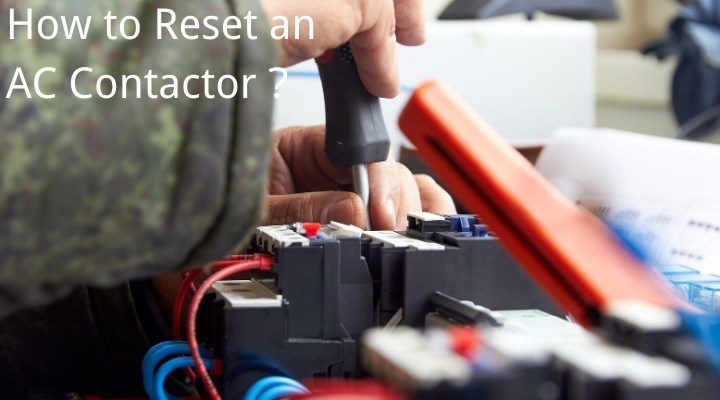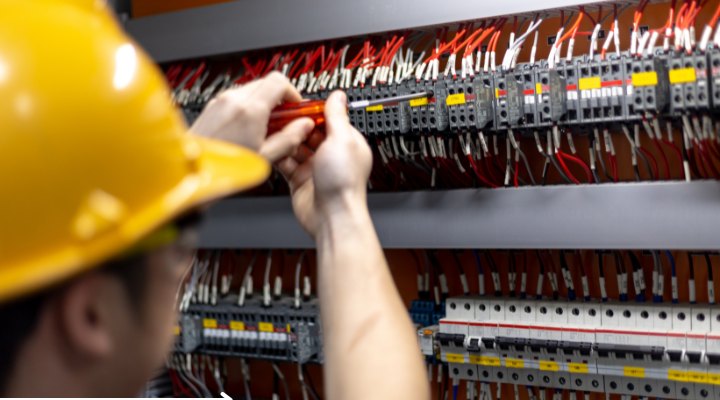AC contactors act as a gateway to electricity and ensure that your equipment runs smoothly. However, due to the passage of time, AC contactors have been known to suffer from many electrical faults, breakages, and overheating.
To address these issues, in this blog, we will delve into the importance of AC contactors, why they may need to be reset, and provide you with concise steps for the reset process.
Table of Contents
ToggleWhat is an AC Contactor?

An AC contactor is an electromechanical switching device that is a core component in an air conditioning system, used to control the flow of current to the compressor and condenser fan motor.
AC contactors are mainly composed of coils, relay contacts, and terminals, which work in tandem to ensure the normal and stable operation of your air conditioning unit.
Click to learn: Understanding AC contactors
Why does an AC contactor need to be reset?
The reasons why an AC contactor needs to be reset are usually related to the following:
- Electrical Failure: If the contactor encounters voltage fluctuations or short circuits, this may result in damage to the internal components, which may require resetting or replacement.
- Mechanical Failure: Mechanical parts of the contactor, such as contacts or springs, may be worn out or jammed due to prolonged use, interfering with their proper functioning and requiring adjustment or resetting.
- Overheating protection: Contactors may overheat after prolonged or overloaded operation, triggering the built-in protection mechanism, which needs to be reset to restore normal function.
- Maintenance and Inspection: During regular maintenance, contractors may be inspected and reset to ensure the safe and efficient operation of the equipment.
Resetting the AC contactor is to ensure proper operation and extend its life.
Safety Tips for Resetting AC Contactors
Before officially resetting the AC contactor, you need to understand the relevant components of the AC contactor and know the following points in advance to ensure safety:
- Locate the main circuit breaker that supplies power to the air conditioning unit.
- Turn off the circuit breaker and make sure no current is flowing.
- Make sure the power is completely off before proceeding.
- Wear insulated gloves and goggles for safety.
- Insulated gloves will protect you from electric shocks, while goggles will protect your eyes from any debris.
- Make sure you have the proper safety equipment for maximum protection.
How to Reset an AC Contactor

Before you start resetting the AC contactor, please prepare a few tools in advance to make it easier for you to start the official reset operation down the road.
- Screwdriver: an essential tool for safely opening the AC unit.
- Multimeter: helps to check the current accurately.
- Insulated gloves: protect you from potential electrical hazards.
- Goggles: protect your eyes while performing maintenance tasks.
If you don’t have these tools at home, you can choose to look for a variety of screwdrivers and multimeters at your local hardware store. Or you can buy a variety of insulated gloves and goggles on online retail platforms such as Amazon.
After you have these tools at hand, you can begin performing the AC contactor reset tool. Here is a step-by-step guide on AC contactor reset:
Step 1: Turn Off Power
Start by locating the main circuit breaker that powers the air conditioning unit, which is usually located in the electrical panel.
Locate the switch associated with the air conditioning system and turn off the circuit breaker to ensure that no current flows into the air conditioning unit, which will effectively prevent any electrical mishaps from occurring during the reset process.
Step 2: Accessing the AC Contactor
Carefully open the air conditioning unit according to the manufacturer’s guidelines or instructions. Make sure you have enough space to work comfortably around the contractor without any obstructions.
Once you have access to the internal components of the AC unit, locate the contactor. It is a small box-like device with wires attached to it. Make a note of its location and how it fits into the system.
Step 3: Inspect the Contactor
Carefully inspect the contactor for signs of wear, damage, or burn marks. These visual clues may indicate that the contactor has failed and may need to be reset or replaced.
Make sure to gently clean any dirt or debris that has accumulated on the contactor using a soft brush or soft cloth with the power turned off, ensuring that there are no obstructions on the contactor that could affect its performance.
Step 4: Resetting the Contactor
Manual Reset Process
- Begin the manual reset process by gently pressing the contactor relay switch to reset the assembly.
- Apply a small amount of pressure while resetting to ensure the contactor is fully engaged.
- This operation will help restore the proper operation of the AC contactor and resolve any potential problems.
Using a Multimeter to Check Functionality
- Utilize a multimeter to accurately measure and evaluate the current in the AC contactor.
- Using the multimeter check function ensures that all electrical connections are intact and operating properly.
- This step provides a thorough evaluation of the contractor’s performance, allowing you to effectively identify any potential problems.
Alternatively, if you have not been able to resolve the problem using the steps above and the air conditioning system still appears to be not working, you can additionally check for these conditions:
- Verify that the circuit breaker is working properly and supplying power to the air conditioning unit.
- Check the thermostat settings to make sure they are configured accurately for cooling.
- Check for dirt or clogs in the air filter that could block airflow.
Step 5: Seek Professional Help
If all the troubleshooting steps fail to solve the problem, you can seek help from the team of expert HVAC technicians at MOREDAY. For complex electrical problems or component replacement that goes beyond basic maintenance tasks, it is recommended to seek professional help.
By following the troubleshooting steps outlined above, you are confident that you can effectively resolve AC contactor-related issues and ensure that your system operates efficiently throughout its lifespan. Of course, proper maintenance is the key to prolonging the life of your AC contactor.
At the same time, you can also learn about the detailed guide on how to set up a timer switch, I hope it can help you!
Maintenance Tips for AC Contactors

Regular maintenance of the AC contactor can be the key to ensuring its long-term effective operation. Here are some basic maintenance tips:
Periodic Inspection
Periodically inspect the contactor’s appearance and electrical connections. Inspect the contactor at least every six months, looking for any signs of wear, such as contact point burnout, damaged coils, or loose connections.
Clean Contacts
Periodically clean the area around the contactor, using a soft brush or cloth to gently clean the contactor and remove any dirt, debris, or buildup that could prevent it from operating. When cleaning the contactor, avoid using harsh chemicals or abrasive materials that could damage its components.
Test Coil Resistance
Use a multimeter to measure the resistance of the coil to ensure it is within the manufacturer’s recommended range. Abnormal resistance values may indicate damage to the coil.
Functional Tests
Perform functional tests periodically to ensure that the contactor opens and closes properly. Listen to any unusual noises during the test, which may indicate internal mechanical problems.
Replace Worn Parts
If inspection reveals severely worn or damaged parts, replace them immediately to avoid contactor failure.
Record Maintenance Activities
Record the date of each maintenance visit and the actions taken. This can help track the condition of the contractor and predict future maintenance that may be required.
Follow the above tips to properly maintain the AC contactor. In addition, you can pre-apply a thin layer of dielectric grease to the electrical connections to prevent moisture and corrosion. Keep the area around the contactor free of obstacles and debris to ensure proper ventilation and cooling.
Conclusion
By following the steps above, you can easily reset the AC contactor yourself, but for safety reasons, please consider consulting or hiring a professional to help check and reset the AC contactor if necessary.
Proper maintenance techniques will not only prevent damage to the AC contactor but will also increase the life of the AC contactor!
Purchasing a safe AC contactor can effectively solve some problems from the root, please consult Moreday’s sales staff to get an accurate quote, whether wholesale or retail, we have support, so come to contact us!

